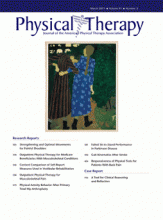Congratulations to Dr Mulroy and colleagues on the publication of an important and high-quality randomized controlled trial investigating the effectiveness of an exercise and movement optimization intervention on shoulder pain in people with paraplegia from spinal cord injury.1 This investigation incorporates several strengths, including a large initial sample of participants with shoulder pain, an attention control group, a 12-week intervention, a follow-up 4 weeks postintervention, and blinding of the assessing therapist. The investigation is particularly important given the reliance of these individuals on their upper extremities as their means of mobility. The investigation demonstrated significant improvements in the intervention group that were not present in the control group and that were retained at the 4-week follow-up. This finding was demonstrated by significant interaction effects and significant within-group effects over time in the intervention group. I am curious as to why the authors did not follow up the interaction effect by comparing the groups at each of the time points. This follow-up would have strengthened the ability to directly say the benefits to the intervention …
You may be able to gain access using your login credentials for your institution. Contact your library if you do not have a username and password.
If your organization uses OpenAthens, you can log in using your OpenAthens username and password. To check if your institution is supported, please see this list. Contact your library for more details.
You may purchase access to this article. This will require you to create an account if you don't already have one.












